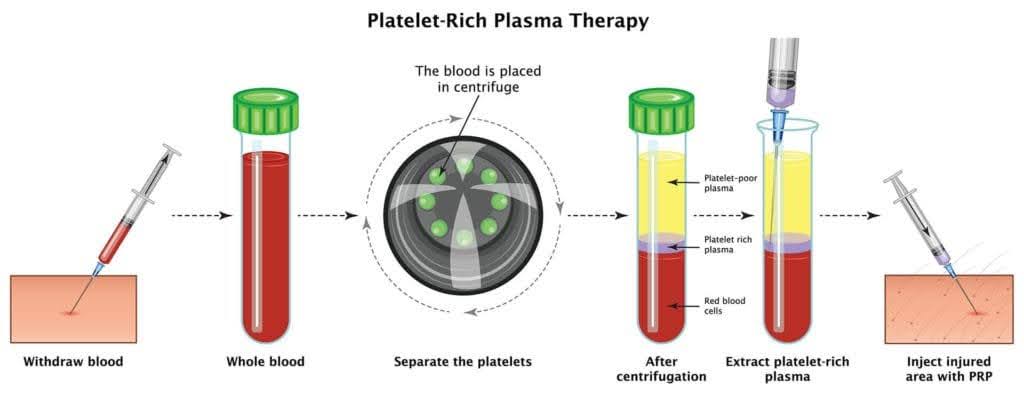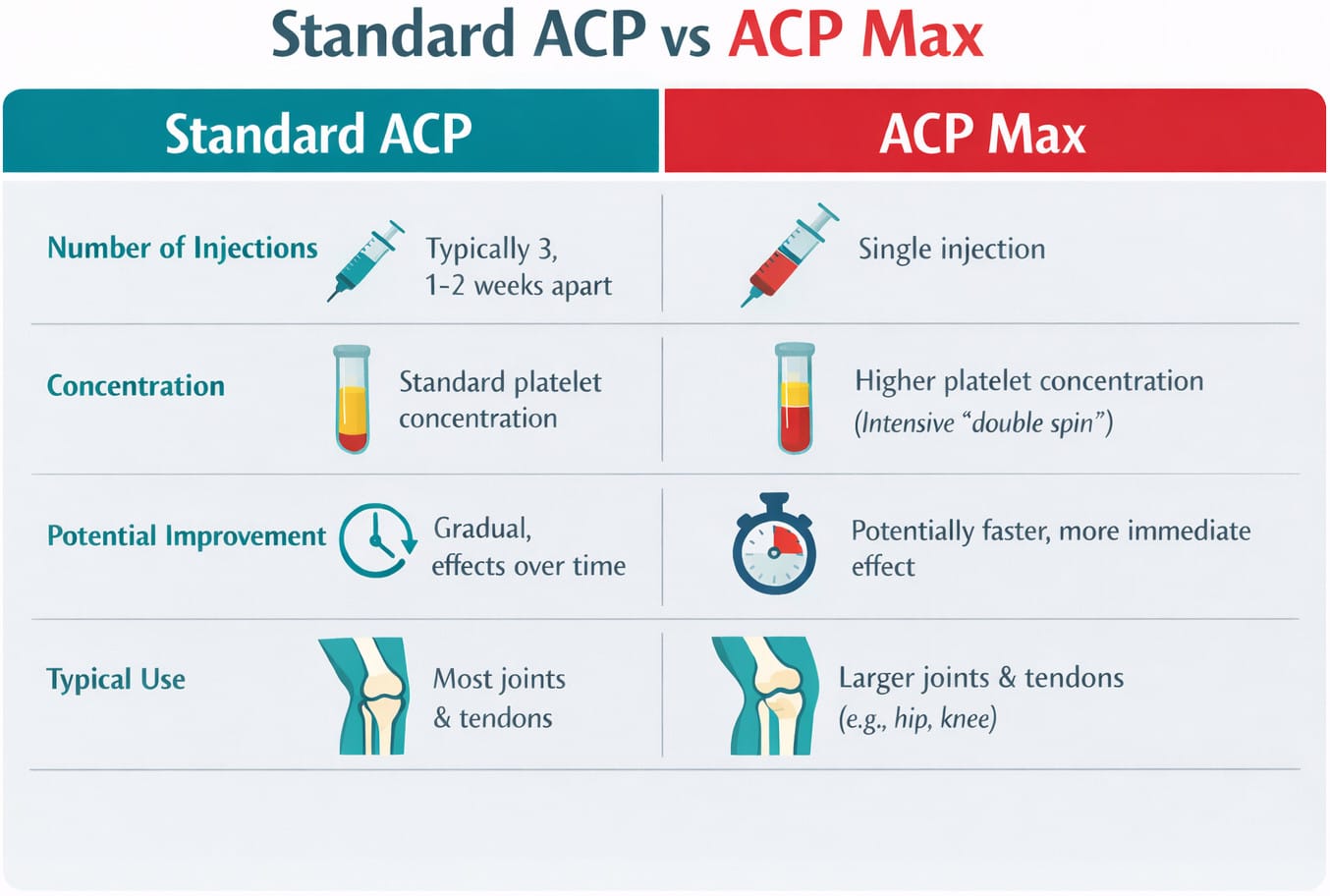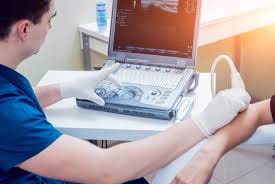Platelet Rich Plasma (PRP) Injection
Our one-stop shop ultrasound guided injection clinic making access to pain relieving injections as easy as possible for patients whilst offering the highest levels of expertise and patient care.
Platelet Rich Plasma (PRP) Injection
Platelet Rich Plasma (PRP) injections can provide long-lasting pain relief for a range of degenerative joint and tendon conditions, including osteoarthritis and tendinopathies. Many patients experience improvements for up to a year, and sometimes longer. As with all injection treatments, there is a risk of side effects, though these are uncommon.
Our clinicians have extensive expertise in performing PRP injections for a variety of conditions. The purpose of this patient information page is to give you the key details you need to prepare for your injection and to understand the post-injection care process.
When is PRP used?
PRP (Platelet Rich Plasma) injections can be used to treat a wide range of joint and soft tissue conditions where pain and degenerative changes are present. These include:
- Osteoarthritis in joints such as the knee, hip, shoulder, and ankle
- Tendinopathies (e.g. tennis elbow, Achilles tendinopathy, rotator cuff tendinopathy)
- Muscle injuries and partial tendon tears
- Chronic ligament problems
PRP works by concentrating the body’s own growth factors to help stimulate healing, reduce pain, and improve function in areas that may not fully repair on their own.
What is PRP and how is it produced?
PRP (Platelet Rich Plasma) treatment involves taking a small sample of your blood, usually from a vein in your arm. The sample is placed in a centrifuge, a specialist machine that spins the blood at high speed to separate it into its different components. One of these components, plasma, is rich in platelets — containing two to five times the normal concentration.
Research has shown that this platelet-rich plasma can have a regenerative effect on tissues by stimulating the body’s natural healing processes. The prepared PRP is then carefully injected, under ultrasound guidance, into the area of pain or degeneration, such as a joint, tendon, or muscle.

How Many PRP Injections Do I Need?
The number of platelet-rich plasma (PRP) injections you need will depend on your condition and will be discussed at your appointment. There are two main treatment options: standard ACP and ACP Max.
Standard ACP is usually given as a course of three injections, one to two weeks apart. This staged approach often delivers better results, as the treatment builds up over time.
ACP Max is a single, more concentrated injection, produced by taking more blood and processing it more intensively — sometimes with a “double spin” method — to achieve a higher platelet concentration. It is typically offered for larger joints and larger tendons, such as the hip or knee. It is not usually suitable for smaller joints or small tendons.
The most appropriate option for you will depend on various factors, including the structure being treated and the findings of any ultrasound or MRI scans. These will be reviewed fully with you on the day.

What is the difference between ACP and ACP Max?
As discussed above, ACP refers to the standard PRP approach, usually delivered as a three-session treatment over several weeks. ACP Max is a one-off, higher-strength alternative, created by processing a larger volume of blood to produce a more powerful platelet concentrate.
The key distinction is that ACP Max is generally reserved for larger joints and larger tendons, where a higher concentration is beneficial. Smaller joints and small tendons typically respond better to the standard ACP course.
Your clinician will talk you through which option is best suited to your condition, taking into account the area being treated and the results of any imaging.
What Happens When I Have A PRP Injection?
First, the clinician who will be performing your injection will give you a call to discuss the procedure and make sure it’s the correct treatment for you based upon your condition and symptoms. They will also screen you for any medical conditions which would prevent you having the treatment. For safety reasons your clinician may recommend delaying your injection until consent has been obtained from your GP if there are any concerns regarding your general medical condition.
There are a few things you also need to be aware of in preparation for the day of the treatment such as keeping yourself well hydrated. The appointment will last around 30 minutes in total. First the clinician will draw some blood, usually from a vein in your arm. Then the PRP needs to be prepared by spinning the blood in a centrifuge which takes around 10 minutes. The clinician will then inject the PRP using ultrasound guidance into the joint or tendon to be treated. An ultrasound scan is used to find out more about the condition of the joint or tendon and also to deliver the injection more precisely. Most injections are quick and easy to perform.

What Happens After The Injection?
Some patients will experience some pain for a week or two after the injection. This is known as ‘post injection flare’ and is usually nothing to be concerned about. It certainly does not mean that the PRP injection will not be helpful for you once the initial discomfort has settled.
You may wish to consider arrangements for getting home after your injection, because the joint or tendon can be painful so it may not be appropriate or practical to drive home after the injection.
Also, please consider your activities for the first few days after the injection particularly with the potential of post injection flare. We recommend that patients have the option to have relative rest for 5-7 days after the injection. Try to avoid strenuous exercise for first 5 days after the injection even if feeling comfortable. If you are having an injection around a tendon, you may be asked to avoid heavy impact and loading activities for two or three weeks. Injections around tendons are more likely to have post injection flare and the flare is more likely to last for longer.
Possible Risks And Side Effects
Most people have PRP injections without any side effects.
The main side effect is post injection flare as discussed above. Other risks and side effects are extremely rare and are listed at the end of this page. If you would like to discuss any of these further please contact your treating clinician prior to the appointment. You will also have the opportunity to discuss in further detail on the day of your appointment.
Will It Hurt?
The injection may cause some discomfort at the time, though most people find it less severe than expected. Mild pain at the injection site can persist for 1–2 days, and a post-injection flare may last for 2–3 weeks.
Infection
Very rarely, you may get an infection in the joint at the time of injection (this is thought to occur approximately 1:50,000 injections). If the joint becomes very painful and hot, you should seek medical attention immediately, especially if you are also feeling generally unwell.
Other Possible Side Effects
Some injections may cause trauma to local tissues. The injection will be performed under ultrasound guidance by a highly experience clinician so this would be a very rare complication and every effort is taken to avoid trauma to nerves or vessels.
Can I Take Other Medications When Having PRP Treatment?
You can take other medicines with PRP injections, however, we recommend to avoid use of NSAIDs (non steroidal anti-inflammatory drugs such as ibuprofen or naproxen) for 1 week before, and 4 weeks after your treatment as this may have a negative impact on the treatment effect of the PRP injections.
Risks Of Complications With Other Medications
Generally, there is no increased risk of complications with most medications. However, certain blood-thinning medications, known as anticoagulants, may require extra precautions. Standard low-dose aspirin, for example, is usually safe and does not need to be stopped.
Pregnancy And Breastfeeding
Unfortunately, we are not able to offer PRP injections to patients who are pregnant or breastfeeding. There is a lack of research into this area in order to robustly demonstrate that it is safe and entirely without risk.
If you have any questions regarding the information contained in this leaflet, please call 02074823875 or email injections@complete-physio.co.uk and we will arrange for one of our clinical specialists to speak with you.

